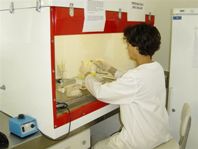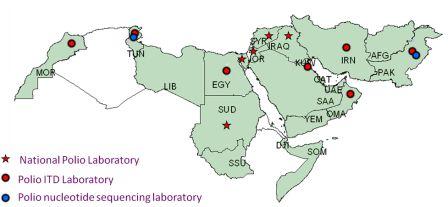 Polioviruses are isolated in polio laboratories from faecal samples of acute flaccid paralysis casesThe Eastern Mediterranean Region Polio Laboratory Network was established in 1991 by WHO and national governments. Its key role is to provide virological information that can be used to target and focus resources on eradicating and, in the case of importations, containing the spread of wild polioviruses. The Network consists of 12 laboratories in a three-tiered structure. (Map 1)
Polioviruses are isolated in polio laboratories from faecal samples of acute flaccid paralysis casesThe Eastern Mediterranean Region Polio Laboratory Network was established in 1991 by WHO and national governments. Its key role is to provide virological information that can be used to target and focus resources on eradicating and, in the case of importations, containing the spread of wild polioviruses. The Network consists of 12 laboratories in a three-tiered structure. (Map 1)
National polio laboratories
virus isolation of polioviruses from faecal samples collected from AFP cases, using standardized procedures and reagents. There are 12 national laboratories (Egypt, Islamic Republic of Iran, Iraq, Jordan, Kuwait, Tunisia, Morocco, Oman, Pakistan, Saudi Arabia, Syrian Arab Republic, Sudan). Countries without national laboratories are served by others in the network; Afghanistan is served by Pakistan. Bahrain, Qatar and United Arab Emirates are served by Oman. Lebanon is served by Syrian Arab Republic, Libya is served by Tunisia. Yemen is served by Egypt and Oman. Djibouti, Somalia and South Sudan are served by the Kenya Laboratory which is not part of the Eastern Mediterranean Region network.
Polio intratypic differentiation laboratories
There are seven intratypic differentiation laboratories (Egypt, Pakistan, Islamic Republic of Iran, Oman, Kuwait, Tunisia and Morocco), which serve as national laboratories to their own countries and to other specified countries which do not have the capability to perform intratypic differentiation laboratories of poliovirus isolates to confirm whether any polioviruses detected are wild or vaccine virus or a virus that may have originated from the oral polio vaccine (i.e. are vaccine-derived polioviruses)
Polio nucleotide sequencing laboratories
The network laboratories are using real-time reverse transcription polymerase chain reaction (rRT-PCR) for intratypic differentiation laboratories and screening of vaccine derived polioviruses. There are two in the Region (Pakistan and Tunisia). All wild viruses are subjected to nucleotide sequencing to monitor the virus transmission pattern and relationships.
Map 1: the map describes national viruses isolation, intratypic differentiation and nucleotide sequencing laboratories.

The Eastern Mediterranean Region Polio Laboratory Network is subject regularly to accreditation visits and all the network laboratories are accredited. As well, the responsible officers for the network meet every year to develop recommendation to improve performance and adapt new technologies and methods.





